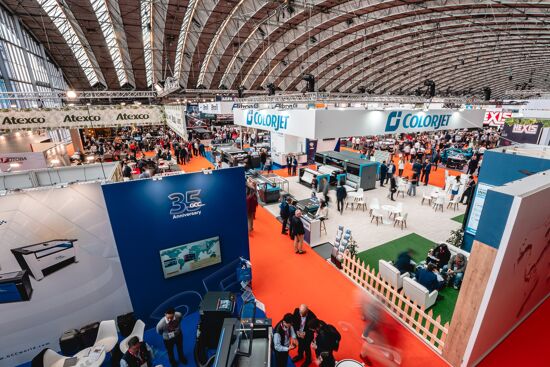Adopting AI in the Garment Decorating Industry
_1.png?width=750)
Marshall Atkinson discusses the new opportunities provided by utilising AI in garment decoration. Marshall also covers AI-driven metrics and AI-driven customer experiences.
We live in an amazing time currently. Do you recognize that? Artificial Intelligence is moving into all corners of business and society, bringing a wave of new uses. Hopefully, you have been paying attention and trying out some new ideas.
The Beatles released a new song with AI helping with the John Lennon sections in the past year. Billy Joel recently pushed out a new video with a new song that has him singing in the video in various stages of his life.
As amazing as those accomplishments are in music, that is nothing compared to the achievements using artificial intelligence that you can use right now in your business. Have you tried these yet?
Inventory Management
Your company invests a considerable amount of money in inventory. Not just the garments but the inks, consumables, print heads, spare parts, boxes, and other items that are constantly necessary to make the magic happen. Do you know EXACTLY what is in the building, how many times a year you are ordering, and when the next time you need to order something?
Probably not.
Worse, you have boxes and skids of items you have bought stuck up on a rack with layers of shrink wrap around them. What is that stuff anyway? Is it still good? Could you use something for an order coming in next Tuesday? Nobody knows.
This is why one of the best AI practices will focus on inventory management. Why? Because AI can connect multiple data points such as stock levels, reorder needs, lead times, and work in progress with other factors such as cash flow forecasts and customer demands. Can you imagine hooking up the power of an inventory management system like Sortly with an AI-powered control program?
The great benefit of using AI is that the tool can be trained to analyze data to reveal critical insights regarding the inventory and purchases your business makes that you would never likely discover yourself. When you link information and data regarding your supplier’s performance and even your customer’s buying frequency, the AI-powered report could help you make better-informed decisions. This includes real-time reporting for warehouse picking, packing, and shipping.
Quality Control
Around the corner right now are some solutions for quality control that will be a tremendous benefit to high-volume print shops.
Shops rely on people to visually check the quality of their printed production. This means a person has to review each shirt as it is being printed and check for color, registration, and any deviations in the print. Even shops with great employees miss some problems as they are hustling to complete jobs, or employees are not as sharp at the end of a shift. Humans can only do so much.
 Credit: M&R
Credit: M&R
M&R is set to release its new Image Capture System Series 100 in 2024. This ICS system was specifically developed to monitor press output to identify significant deviations in the final printed image. It starts with an operator-approved master image. Each subsequent final print is automatically compared to the approved master image. The system's sensitivity can be adjusted to a level where even small pinholes can be detected.
The system uses AI to compare the approved image to each printed image. Any deviations trigger an alarm so the production team can resolve it.
Anything with Text
How often are you writing something in your business? Emails, product descriptions, blog articles, responses to upset clients, or anything where you need to sit down and compose your thoughts.
With tools like Bard, ChatGPT, or Copilot, you can have a handy helper craft the perfect way to say something.
Here’s a fun experiment. In the prompt instructions, write:
“Write an SEO-friendly product description for a t-shirt design for a high school online web store. The school is Leon High School, and they are called the Lions. The shirt color will be Vintage Heather Red. The graphic will be a fun, three-color design on the front for the Class of 2024. Be fun, casual, and humorous. This is for high school seniors.
Here is the product description: 5.4 oz./yd² (US), 9 oz/ L yd (CA), 50/50 cotton/polyester Oxford is 47/53 cotton/polyester Pre-shrunk Advanced moisture management performance Noticeably softer hand & excellent printability Shoulder-to-shoulder taping Double-needle stitched sleeves, bottom hem, and front neck 1x1 ribbed seamless collar Quarter-turned Tear away label”
In about 45 seconds, AI will deliver a nearly perfect custom-tailored SEO product description for your online store for the school. In my tests, ChatGPT even included puns and jokes in the description to cater to the fun of being a teenager.
But wait, there’s more!
Any of these AI platforms can help you craft employee handbooks, schedules, drip marketing emails, blog articles, and even spreadsheets with graphs if you plug in the numbers.
Image Creation
It’s no secret that I’m a big fan of Midjourney. As a former art director, I wish I had this tool back in the day.
Why?
Because your creative team is usually stressed to the maximum limit with work trying to create the “perfect” image for customers. Let’s face it: better art sells better.
Whether or not you are screen printing a t-shirt, designing patterns for bolts of fabric, or doing some DTF print-on-demand work, getting higher-quality images in a shorter time frame is important to you.
I like Midjourney because the images that are created are simply better. However, there is a fee to use the platform, and many people successfully use DALL-E3, which is hosted on Bing.
Literally, anything you can dream up, these platforms can deliver. The trick is that all image creation on these platforms is based on word prompts instead of the normal design tools that creative professionals use. This means that people with better vocabularies and word choices may have better results than people with a limited way with words.
Are these platforms perfect? Hardly. However, someone trained to use them can quickly develop images (in under one minute) that can be edited and manipulated in more standard design programs.
These programs work by starting off with random image noise, similar to static. The tools are trained on the LLM model, (Large Language Model), which matches trillions of images with image-to-word pairs. So when a user types in Blue, Banana, the AI matches up what it considers to be blue with what it considers to be a banana. Because it starts with random noise, every result will be completely different. Nothing is repeated.
Better word prompts produce better results. Take it from me: it is simultaneously amazing and frustrating.
What’s Next?
This article doesn’t even come close to scratching the surface when considering artificial intelligence's impact on the industry. As soon as something is typed, another AI solution may be launched. We are moving at that speed.
To that end, predicting the future with AI might be fun. Remember, you read it here first. In no particular order, what if:
AI-Driven Phone Designing System Based on Voice
Here’s the idea. Voice search is already a great way to market. What if a user could use voice search in a new way, where they could speak a preference into their phone, AI designs something, and four choices are sent for approval? The user’s size preferences, address, and credit card info are already loaded, and with fingerprint approval, the custom print-on-demand order is in the queue and ships out the same day.
What would be remarkable here is that there won’t be any buttons to click, information to enter, or delay.
The even more amazing thing is that the data collected on what is selling - garment styles, colors, designs, images, and customer locations, help drive better decisions for the company in other areas, too. Artificial intelligence helps the company respond faster and more accurately because it is based on real-time information.
It is a known fact that the fashion industry is the second largest polluter on the planet, as brands produce more garments than sell constantly. What if AI could help fashion brands only produce what the consumers would actually like and buy, as it is based on engagement with the customer at the point of sale? Nothing is produced until it is bought.
AI-Driven Metrics
Here’s the idea. We all know that you can’t manage what you don’t measure. Yet, too few companies keep up with their Key Performance Indicators to help make valuable business decisions.
Using a network of cameras, scanners, and connected equipment, any shop in the industry can instantly access production, inventory, sales, and financial data. Imagine being able to know the answers to these questions instantly!
-
What is today’s net profit margin compared to this same day last year?
-
Which jobs we produced last month were the most profitable and why?
-
What do our top twenty customers have in common? This data suggests that our sales team should pursue twenty more customers and a sales action plan for each.
-
Analyzing our production data, would it make sense to purchase new equipment if the ROI is under 18 months? What would be the best capital investment to reduce our downtime percentage and be more efficient?
This could be possible if everything in the shop were connected.
AI-Driven Customer Experiences
Regardless of what segment of the industry your business may be in, you exist because of your customers. Without them, you are doomed.
So, what boundaries need to be pushed with AI? How can you deliver a more personalized and enriched experience for the number one thing that matters most in your business…your customers? How will you hook up new tools such as Smart Glasses, virtual try-ons, and bespoke measurements with a custom-tailored fashion with a phone app?
Experiential marketing is hot currently. Social media is too noisy. Creating a better experience with engaged customers is where the marketing thinking is going. Artificial intelligence is playing a key role in that development.
Can one of your customers participate in a virtual fashion show with the latest trends? What if they had a virtual experience walking down the runway, or front row seats at the fashion show? As a supplier, how can you help your companies enable that type of experience for their customers?
With the development of word prompt-based movies, could you develop marketing that delivers a personal experience unmatched by today’s marketing? Will this be the next marketing “arms race” for attention?
Topics
Interested in joining our community?
Enquire today about joining your local FESPA Association or FESPA Direct
Recent news

European Sign Expo to highlight developments shaping the future of signage and visual communications
European Sign Expo 2025 (6 – 9 May, Messe Berlin, Germany) is weeks away and a host of leading exhibitors are all set to welcome Visionaries from across the signage and visual communications industries to their stands.

Adding sparkle to personalised print with special effects
With demand for personalisation on the rise, Rob Fletcher looks at how offering customers the option to add special effects to their printed work can help you win new business and expand into new markets.

Kernow Coatings to showcase innovative solutions at FESPA 2025
Kernow Coatings will showcase innovative, sustainable wide-format printing solutions at FESPA 2025. Highlights include a collaboration with Ricoh for a space-themed booth, featuring KernowJet MetaliK and Interiors Structured Silver. They'll also present recyclable wallcoverings and PVC-free media, emphasizing high-performance, eco-friendly options.

Understanding the differences and similarities between monitor and RBG Device ICC Profiles
Paul Sherfield explores the the intricacies of RGB monitor profiles and RGB device profiles, uncovering the challenges and considerations that we can face in the colour management field face daily.